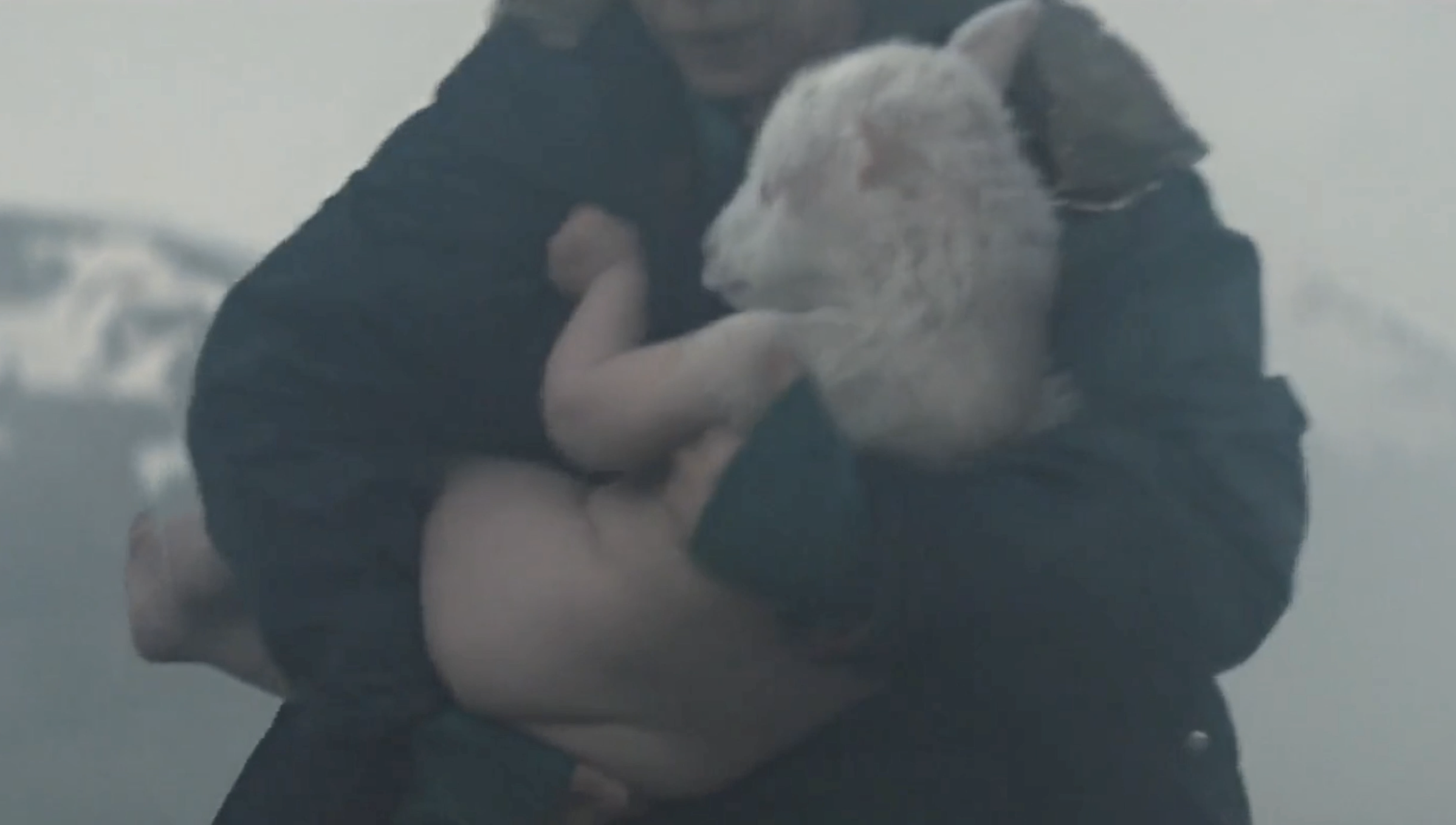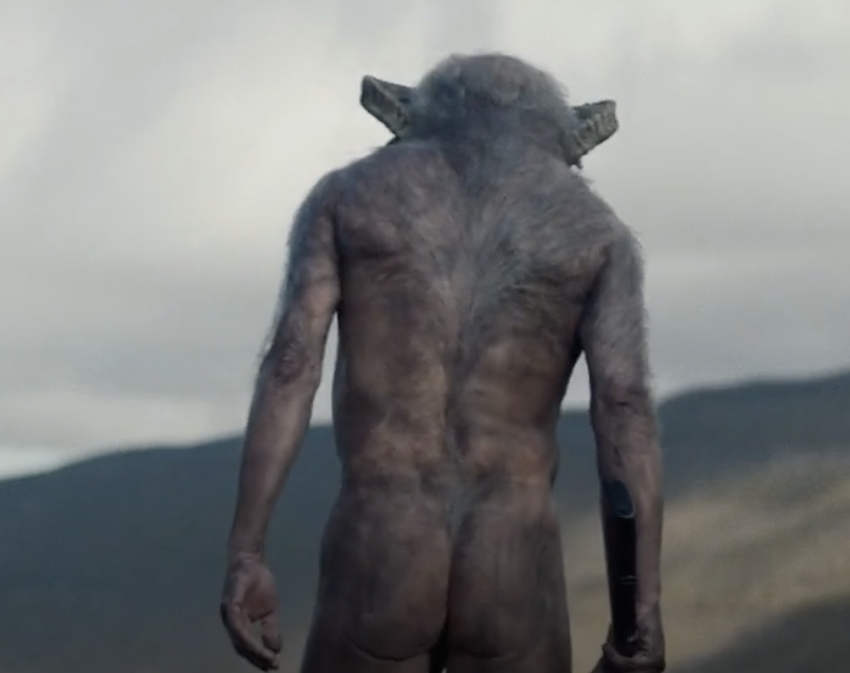A CLOSED LOOP
PICTURES IN ROOMS
FIELD WORK
ARRIVE BY MAGIC
2021/11/22

Ada cradled in mother’s arms
For a good part of the movie Lamb's first chapter, the audience are only shown the head of the baby lamb, whom the farmer couple have taken under their wing and plan to raise as their own, while the rest of its body are wrapped in sheets, reduced to an ambiguous, bulbous volume. For unsuspecting viewers, I imagine they wouldn't be so soon caught up with the fact that something dubious is going to shake loose from these soft and perfectly innocuous baby props. Why would there be anything but the logical continuation of the identifying lamb head, where fur, tail and hooves seem like an inevitability. Coupled with the fact that images of a newborn often have their subject cocooned in blankets, the puzzlingly generalized geometry of the blankets themselves (and what's underneath) easily escapes our suspicion. I think it's more interesting going in with the knowledge of Ada the lambs's physical deviance than to be slowly steered into the couple's potential folie a deux, for that it transforms the dramatic tension into a palpable yet ambiguous object, instead of having to rely on context clues gathered from the performances.

My Ada diagram
In an escalating event of Ada's missing toward the end of chapter one, her secret bears its skin. Immediately jumping out at us are the back and arm of a human child, not only did it subvert the logical inference from the lamb head, but the exposedness of the human flesh also stands in stark contrast to the chilling Icelandic landscape as well as María's hefty winter jacket. Despite being quickly covered back up, it's clear that Ada's lamb parts and human parts are quite distinct. Her human mother's arm conveniently runs along the border where the smooth baby flesh meets the lamb fur, giving away just a small patch on her shoulder, where the white fur fades into skin with the subtlety of a sheer sleeve. It then occurs to me that, of course, hybridity shows up in different forms and to various degrees. In comparison to the ram-man in the final chapter whose fur spreads wild across his chest and back, the way Ada's duality manifests seems inoffensive if not benevolent. Her human-ness and lamb-ness stay put at each side of the border, uncontaminated. It's even somewhat comedic considering that Ada is perceived as human from shoulder down barring one of her arms, which takes up pretty much all the spaces allotted by the mystery blanket (a bad analogy here would be a tan line marked distinctly by an item of clothing). In later scenes, Ada graduates from the baby blankets and begins to put on human clothes, becoming more akin to the characters on Arthur, a personified animal other than some creature teetering on the edge of a breached humanity. If the reveal is meant to induce some sense of horror, it's to little avail. The ram-man, who seems to carry a paternal bond to Ada, is able to strike that note to greater success not only as a result of his actions, but also because his animalism has already infected his humanity in this visual way, that he is clearly beyond the point of domestication.

Ram-man, Ada’s birth father (?)
In a way, Ada's physicality mirrors how we divide her into parts with words, that she is a creature pieced together with distinct, mismatching componens, that she is a human-lamb or lamb-human. There's something quite mechanical about this specific way of imagining hybridity, as opposed to the genetic scramble attempted by Patricia Piccinini's anthropomorphic sculptures. Despite the latter being a more provocative approach, and potentially a better device to cynicism and horror (as demonstrated in real time by how some people are reacting to the mRNA vaccine), I wonder if the shock that's brought forth by the genetic confusion would also irrevocably damage the couple's confidence in bringing Ada to their home. Shifting gears to technicalities, the way special effects operates in this movie does appear to be a lot of stitching disparate parts together in service of an illusory whole, which in itself is a very mechanical process. Looking at the the lamb head puppet and how quickly it cuts off below the neck, as long as it surpasses the edges of the collar, I realize that the contentious border marking Ada's body has once again been concealed in favor of the edges of shirts and pants. In other words, we are left to our own devices to sustain the little flicker of an image that reveals the secret.

The only CG break down of Lamb I managed to find on the Internet, on the right is what I suspected to be a puppet head that’s used in the movie
For the most part, the clothes do a good job of containing Ada's anatomy to our existing framework. However, moments of slippage happen, like the one in the scene where Ada is shown resting in her crate, wearing a baby blue onesie. The onesie seems ill fitted and square, a quality which might have been glossed over if not for her human arm reaching over from the side and resting on what is presumably her chest. Judging from the direction Ada's head is turned, it's difficult to tell whether she is lying on her back or on her stomach. When the parts fail to reach an agreement, their differences become painfully obvious. Ada has always been a temporary solution to the irreconcilables. In the couples' efforts to raise her in their dead child's nursery, and dress her as human, they are in their own ways trying to see past and straighten out her oddities. Yet Ada, against their wishes, skews towards instability and threatens to slip away from her meticulously constructed realness with one awkward pose.

Ada resting in her create as her image begins to destablize from the improbable position